13 Famously Stunning Botticelli Paintings To Know in 2025
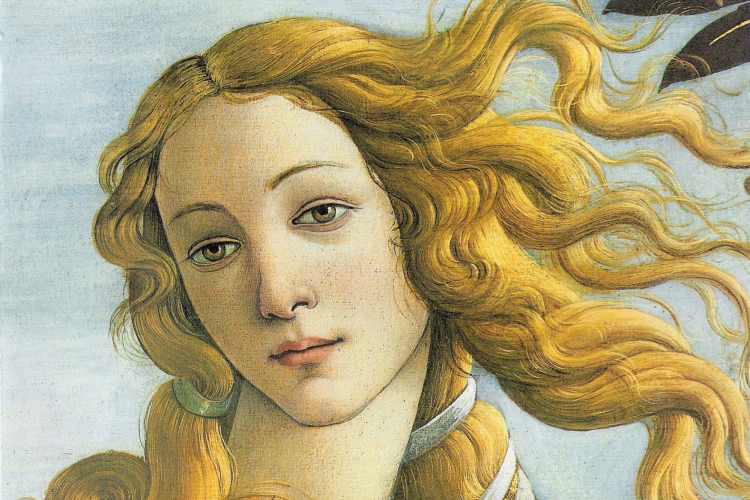
Unlike many artists, Botticelli paintings were famous during his own lifetime, which was the late Renaissance period. But shortly after his death, they fell out of focus from the public eye. Rediscovered during the period of the Pre-Raphaelites, his infamy thrived and has lived on to this day.
Botticelli paintings are filled with references to various myths and folklore, as well as religious scenes and characters, typical of the most famous Renaissance paintings. Delve into the fascinating depths of Botticelli's mind as you continue reading!
Jump to Section
Who is Sandro Botticelli?
Why Was Botticelli Called Botticelli?

When was Sandro Botticelli born?
Alessandro di Mariano Filipepi was born in 1445 and was the son of a Florentine tanner. His father first apprenticed him to a goldsmith, but given his son's love of painting, he found him a new apprenticeship under painter Fra Filippo Lippi who had patrons including the infamous Medici family. “Botticelli” was a nickname given to him, which referred to "botticello" meaning "small wine cask."
You may be wondering, "Why did Sandro Botticelli create art?" or "What did Sandro Botticelli enjoy painting the most?" Botticelli had aspirations to paint the beauty he felt in the world, rather than what he saw — so his paintings often favored an idealistic, imaginative vision over realism.
What Is Special About Botticelli?
Unlike many of the painters of his time, Botticelli's works were famous during his lifetime. He was even requested by the Pope to paint the walls of the Sistine Chapel in 1481.
How did Botticelli die?
That information is unclear. What we do know is the he died in 1510 in Florence after a decline in mental health after years of depression due to political issues affecting his home nation and his view of the world. His final paintings tended to hold darker narratives and be more realistic portrayals of Biblical scenes than his original imaginative beautiful visions.
Where are the Botticelli paintings located?
Botticelli paintings can be found in art museums (and a few private collections) all around the world — from his hometown of Florence, Italy to Paris, London, Berlin, Chicago, Illinois, in the United States of America. Those are only a few examples of the many cities worldwide where Botticelli paintings can be enjoyed in person.
Top Botticelli Paintings
What are Botticelli's 2 most famous paintings? Most likely The Birth of Venus and La Primavera (numbers 1 and 2 in this list). So let's get to understanding why the most well-known Botticelli paintings are so famous and beloved.
1. The Birth of Venus (1485)
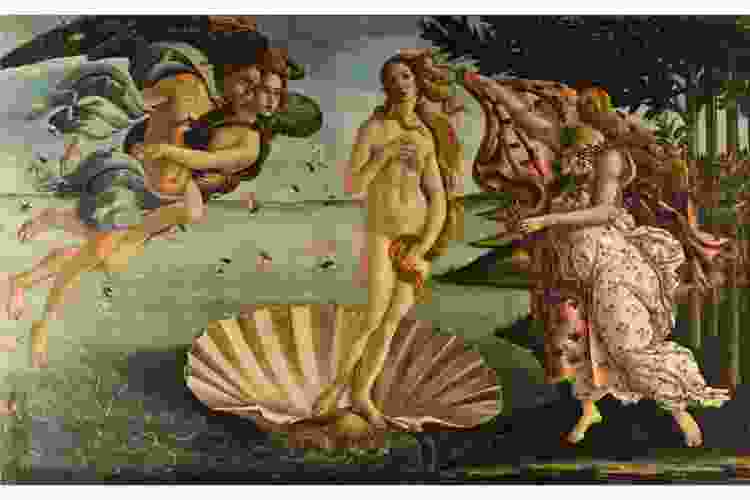
A stunning painting full of deep emotions and magnificent beauty, as well as graceful figures and vibrant, pastel colors, The Birth of Venus speaks to the heart of Botticelli's style and imagination. While Venus stands alone in the center of the piece, she's surrounded by other figures either flying towards her or reaching out for her, retelling stories that relate to her birth.
2. Primavera (1482)
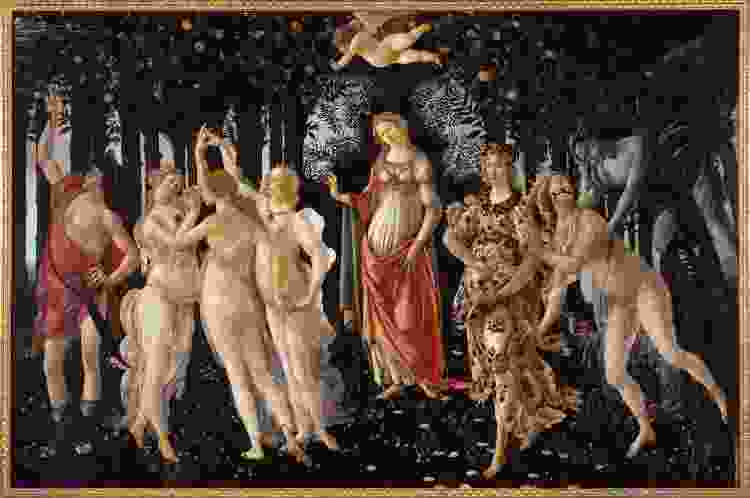
Primavera by Botticelli depicts what seems to be a party! People gather joyously to celebrate and dance in the moonlight. This evening-themed painting is full of vibrant and bright colors, with graceful figures that Botticelli paintings are known to have. Angels of light and darkness float through the sky and through the painting, tempting party-goers to change their ways or join in on the celebration!
3. Fortitude (1470)

This stunningly rendered image, Fortitude by Botticelli, appears to depict a young woman sitting on a throne — perhaps a Queen awaiting her coronation. Or maybe she's a warrior. But her face tells a difference story. Does she wear a heavy crown? Either way, her expression is thoughtful as she considers the small platform her seat is perched upon.
4. Portrait of a Young Woman (1485)

Delight in the graceful features of the brooding lady in the Portrait of a Young Woman by Botticelli. Beautiful jewels adorn her hair and her neck, and the outer part of her dress is white — perhaps she's meant to appear as a pensive bride. The detail that Botticelli put into each strand of this lovely lady's hair shows his commitment to his passion for art, which no doubt played a role in his ability to impress wealthy patrons.
5. Mars and Venus (1483)
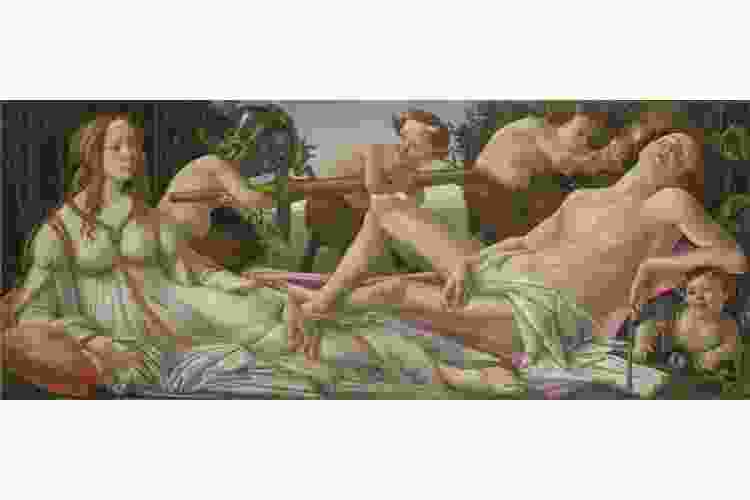
Like many Boticelli paintings, this artwork depicts scene from mythology. It shows the Roman deities Venus, goddess of love and beauty, and Mars, the god of war. The reclining and restful couple are surrounded by baby satyrs, who playfully and mischievously take hold of Mars' weaponry. The entire work shows a particular story in the pantheon of Roman mythology. Mars appears to be sleeping, but Venus is fully awake and appears unhappy or distressed. Lovely images of nature wrap around this narrative Botticelli painting.
6. Adorazione dei Magi (1476)

Translated into English as “The Adoration of the Magi,” this is one of the Botticelli paintings that moves to a more biblical theme. The Three Kings, who visited the baby Christ shortly after he was born, are adorned in gentle pastels, which provide an optimistic and vibrant theme. He has played a little with the architectural concept of the story, since the structure surrounding the family in this work of art is more of a small stone space in the middle of the city, rather than a classic barn structure on the edge of the city. The beauty of the scene is unmistakable.
7. The Mystical Nativity (1501)
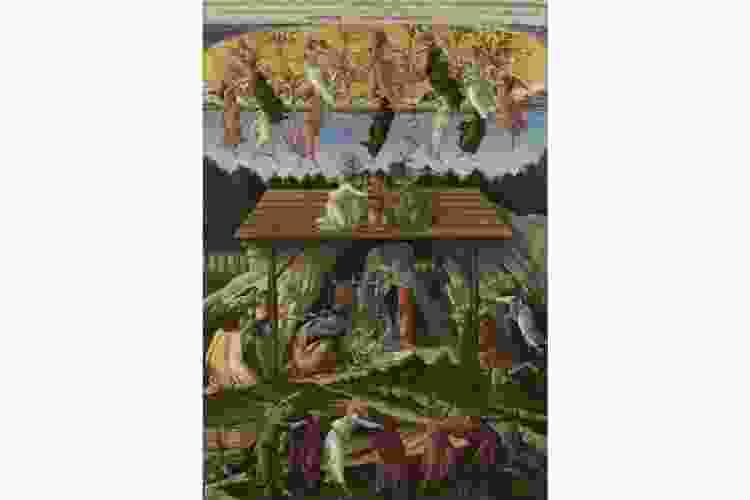
Angels dance through the sky and people everywhere embrace in pure joy at the birth of Christ in one of the most classic Nativity Botticelli paintings. The true spirit of Christmas is embodied in the celebratory depictions throughout this delightful and optimistic piece of art. In a fascinating deviation from the Biblical story, he has created cave-like stone walls for the barn surrounding the happy family, which gives a more Earthy and nature-based tone to the scene. In fact, many Botticelli paintings seem to have nature in the background, if not as part of the main story.
8. Calumny of Apelles (1495)

This gilded-architecture artwork was Botticelli's attempt at recreating a famed ancient masterpiece by Apelles that was lost to time. Still, he maintains aspects of his own style with light and vibrant colors. His intricate details show his masterful style. Look deeply at the wrinkles in the draped clothing of the figures and the curves in the stone that depict mythological characters. Since this was based on a piece of art that was lost, it's possible that the story related to the artwork is also unknown — which means that the viewer will have to guess at the plot of the narrative.
9. Madonna of the Magnificat (1481)
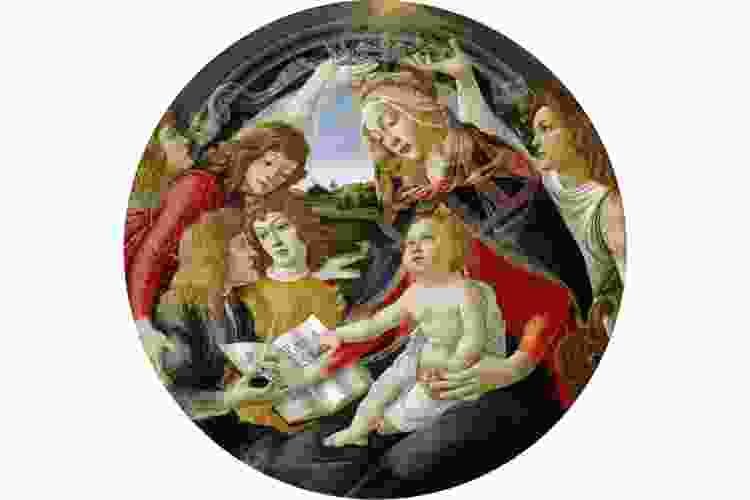
Known in Italian as “Madonna del Magnificat”, this is one of the Botticelli paintings from the time in his career when he was at his most creative and most prolific. This beautiful piece of art portrays an entire community supporting and protecting the Virgin Mother and Baby Jesus, whose eyes are looking towards Heaven while she writes in an open book. The graceful forms and the way each figure fits into the background are signatures of Botticelli's painting style. Though many of his pieces were on a typical rectangular canvas, this is one of Botticelli paintings that was given a circular frame. Round canvas images, also known as “tondi” were popular in Florence at the time that this was painted.
10. The Annunciation (c. 1485–1492)
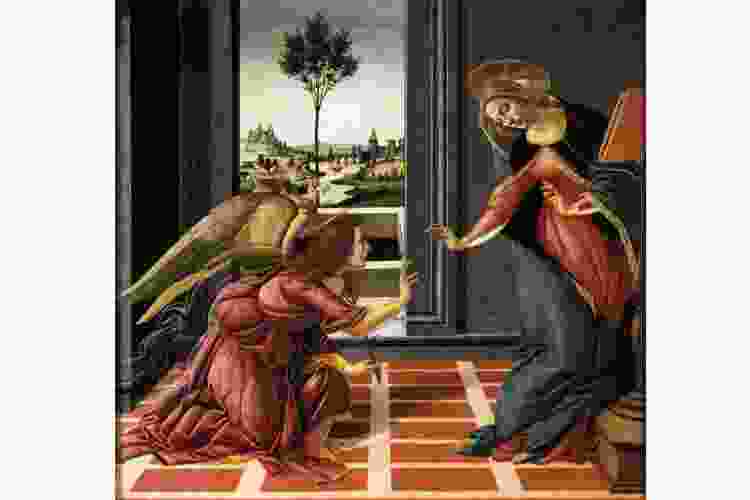
Botticelli paintings featuring Biblical scenes are common, but the beauty of this piece is stellar. Not only has Botticelli captured the gorgeous architecture of what appears to be a historic style of an Italian chapel, he also creates graceful movements and an ethereal quality that adds an element of optimism to the faithful look of the painting. These types of Botticelli paintings moved away from the realistic style that other artists were using in this time period.
11. Madonna of the Book (1480)
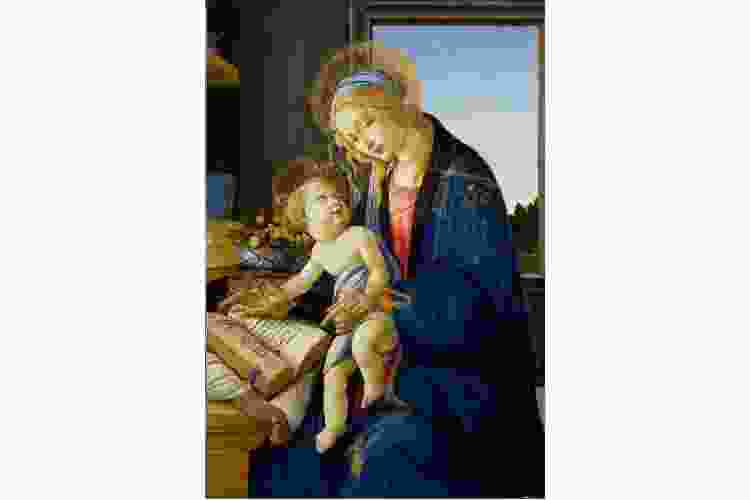
Another one of Botticelli's paintings that depicts the Virgin Mary holding baby Jesus with an open book beside her, though she reads in this one instead of writing. They are alone in a simple cottage, but the figures are just as graceful and full of faith in “Madonna del Libro” as they are in “Madonna del Magnificat.” As was common with Renaissance artwork, Botticelli paintings are full of Christian themes — though he does also branch out into a variety of other folklore and mythological concepts.
12. Portrait of a Young Man (1483)

Although this was painted during the height of Botticelli's creativity, it is full of darker colors and the young man himself wears a sterner expression than most of Botticelli's usual figures — though he is no less full of grace and smooth brushstrokes. There has been plenty of speculation as to whom the subject may have been, though it is possible that this was intended as a portrait of a young Botticelli himself. The mysterious allure of this image makes it clear why it is famous among all the Botticelli paintings.
13. The Story of Nastagio Degli Onesti, Part One (1483)

The story referenced in the title of this painting was written by Boccaccio in an anthology of stories entitled “Decameron”. Along the same lines as Chaucer's Canterbury Tales and Grimm's Fairy Tales, it is a dark story about unrequited love and ghosts — and ends in marriage. This particular work of art is actually the first in a series of four Botticelli paintings allegedly commissioned by a wealthy Florentine merchant for his son's wedding. All together the series of four paintings encompass the majority of the story of Nastagio Degli Onesti.
Botticelli paintings, like many other Renaissance paintings, are beloved by the art community and serve as inspiration — similar to Leonardo Da Vinci paintings. If you're looking for something to surprise your artistically gifted friends, try looking through acrylic painting ideas for beginners. They'll love how thoughtful you are in your gift-giving!
For even more fun art gift ideas, check out other experiences happening on Classpop!

